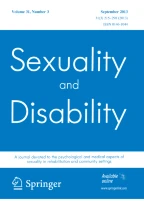756Accesses
4Altmetric
Abstract
Despite having been described for more than a century, there is no understanding of the origin of the attractions, desires and behaviors of devotees, pretenders and wannabes (DPW's). Devotees are non-disabled people who are sexually attracted to people with disabilities, pretenders are non-disabled people who act as if they have a disability by using assistive devices and wannabes actually want to become disabled, sometimes going to extraordinary lengths to have a limb amputated. Two cases are presented in an effort to understand the psychology of DPW's and to suggest one psychologic concept—that of Factitious Disability Disorders—that may explain not only the obsession to be with disabled persons, but also the desire to pretend to be disabled and even the compulsion to become disabled. Also presented is a combined cognitive-behavioral approach to modify DPW's obsessions and compulsive, intrusive, illegal and sometimes self-injurious behaviors.
This is a preview of subscription content,log in via an institution to check access.
Access this article
Subscribe and save
- Get 10 units per month
- Download Article/Chapter or eBook
- 1 Unit = 1 Article or 1 Chapter
- Cancel anytime
Buy Now
Price includes VAT (Japan)
Instant access to the full article PDF.
Similar content being viewed by others
REFERENCES
Storrs B: Devotees of disability. New Mobility 6:50–53, 1996.
Storrs B: Amputees, Inc.: Amputees pitching products and themselves to devotees of disability. New Mobility 7: 26–31, 1997.
Nattress LE: Amelotasis: A descriptive study (2nd Ed). Unpublished doctoral dissertation, 1996.
von Krafft-Ebing E: Psychopathia Sexualis. Brooklyn: Physicians And Surgeons Books, 1932.
Dickes R: Fetishistic behavior. J Am Psychoanal Assoc 11: 303–330, 1963.
Davison C: Intrapsychic factors in the choice of a sexual object. Psychoanal Q 12: 217–222, 1943.
Fleischl MF: A man's fantasy of a crippled girl. Am J Psychother 14: 471–748, 1960.
Stekel W: Sexual aberrations (Vol 2). New York, Horace Liveright, 1930.
Money J: Paraphilia in females: Fixation on amputation and lameness. J Psych Human Sexuality 3: 165–172, 1990.
Wakefield PL, Frank A, Meyers RW: The hobbyist: A euphemism for self-mutilation and fetishism. Bull Menninger Clinic 41:539–552, 1977.
Everaerd W: A case of apotemnophilia. A handicap as sexual preference. Am J Psychother 37: 285–293, 1983.
Hirschfeld M: Sexual Anomalies. New York, Emerson Books, 1956.
London LS: Dynamic Psychiatry: Transvestism-Desire for crippled women (Vol 2). New York. Corinthian Publications, 1952.
Money J, Jobaris R, Furth G: Apotemnophilia: Two cases of self-demand amputation as a paraphilia. J Sex Res 13: 115–125, 1977.
Money J, Simcoe KW: Acrotomophitia, sex and disability: New concepts and case report. Sexuality and Disability 7: 43–50, 1986
Money J: The Adam Principle. Buffalo, Prometheus Books, 1993.
Ollason JG: An interview with Mayda OverGround 5: 12–20, 1996.
Dixon D: An erotic attraction to amputees. Sexuality and Disability 6: 3–19. 1983.
Ollason JG: Why devotees sometimes behave badly. Available: http://www.ardgrain.demon.co.uk/overground/features/theory/whyde.html, 1997, July 7.
Frick NM, Bruno RL: Post-Polio Sequelae: Physiological and psychological overview. Rehabil Lit 47: 106–111, 1986.
Taylor B: Amputee fetishism: an exclusive journal interview with Dr. John Money of Johns Hopkins. Maryland State Med J March: 35–38, 1976.
Woody RH: Integrated aversion therapy and psychotherapy. J Sex Res 9:313–324, 1973.
Ollason JG: Denise Anne: An interview with the ultimate wannabe. OverGround 6:20–35, 1993.
Riddle GC: The origins of devotees' attraction. Invited presentation to the Fascination Conference, Chicago, 1988.
Steen N: Wannabe's page. Available: http://www.geocities.com/HotSprings/8017/, 1997, July 7.
Anderson C: A little about me. Available: http://members.tripod.com/∼paracathy/MYSELF.TXT, 1997, July 7.
Bruno RL: Predicting hyperactive behavior as a cause of non-compliance with rehabilitation: The Reinforcement Motivation Survey. J Rehabil 61: 50–57, 1995.
Blumer D, Heilbronn M: The pain-prone disorder: A clinical and psychological profile. Psychosomatics 22: 395–402, 1981.
Blumer D, Heilbronn M: Chronic pain as a variant of depressive disease. J Nerv Ment Dis 170: 381–406, 1982.
Gentry WD, Shows WD, Thomas M: Chronic low back pain: A psychological profile. Psychosomatics 15: 174–177, 1974.
“Paul:” A letter from Paul. OverGround 6:42–51, 1996.
Riddle GC: Amputees and devotees: Made for each other? New York: Irvington Publishers, 1988.
Stoller RJ: Observing the erotic imagination. New Haven: Yale University Press, 1985.
“Fritz:” A prosthetist's perspective. OverGround 3: 7–15, 1993.
Author information
Authors and Affiliations
Post-Polio Rehabilitation and Research Service, Kessler Institute for Rehabilitation, Saddle Brook, New Jersey; and
Richard L. Bruno
Department of Physical Medicine and Rehabilitation, UMDNJ/New Jersey Medical School, Newark, New Jersey
Richard L. Bruno
- Richard L. Bruno
You can also search for this author inPubMed Google Scholar
Rights and permissions
About this article
Cite this article
Bruno, R.L. Devotees, Pretenders and Wannabes: Two Cases of Factitious Disability Disorder.Sexuality and Disability15, 243–260 (1997). https://doi.org/10.1023/A:1024769330761
Issue Date:
Share this article
Anyone you share the following link with will be able to read this content:
Sorry, a shareable link is not currently available for this article.
Provided by the Springer Nature SharedIt content-sharing initiative
